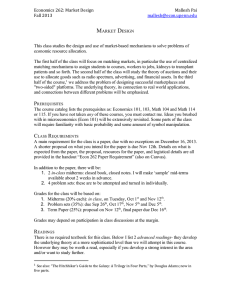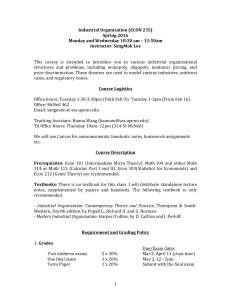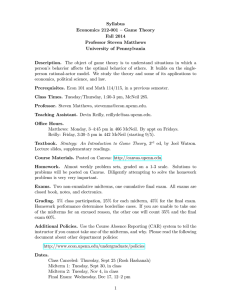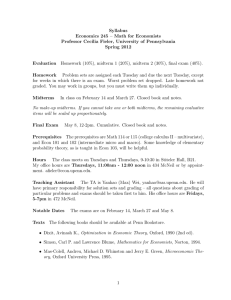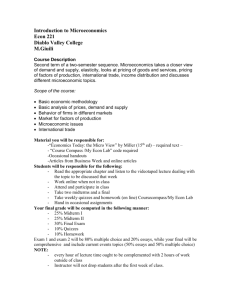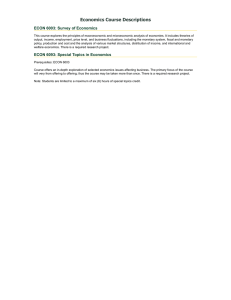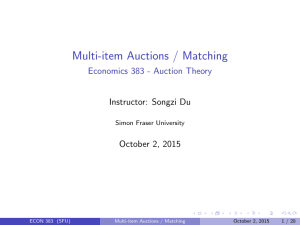M D
advertisement
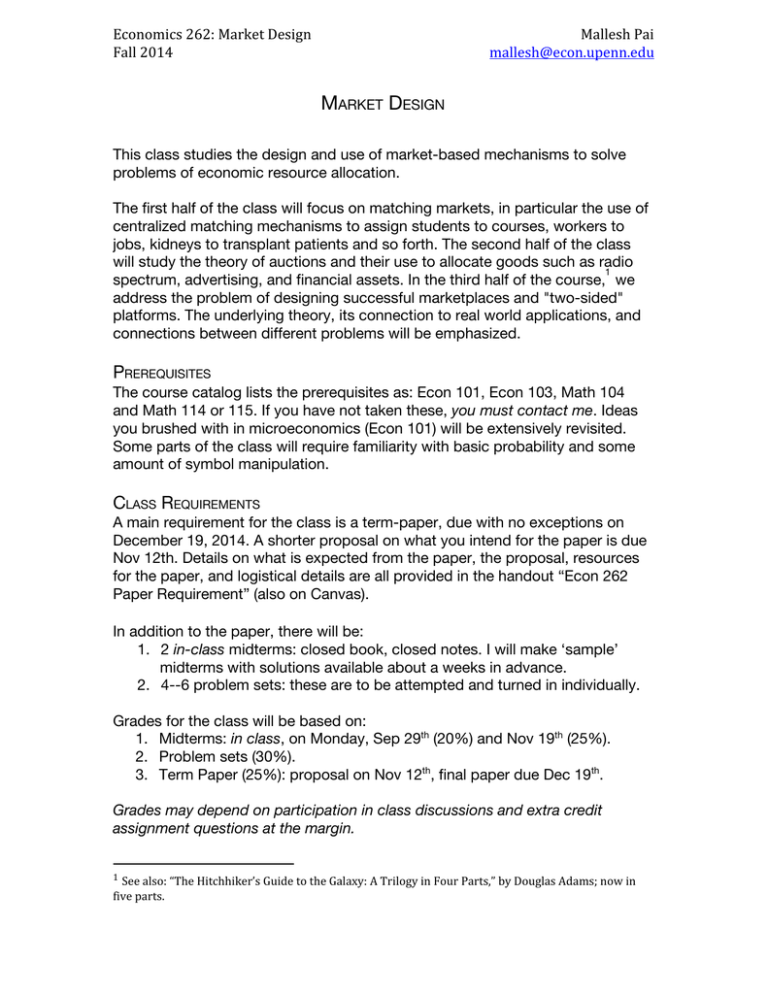
Economics 262: Market Design Fall 2014 Mallesh Pai mallesh@econ.upenn.edu MARKET DESIGN This class studies the design and use of market-based mechanisms to solve problems of economic resource allocation. The first half of the class will focus on matching markets, in particular the use of centralized matching mechanisms to assign students to courses, workers to jobs, kidneys to transplant patients and so forth. The second half of the class will study the theory of auctions and their use to allocate goods such as radio 1 spectrum, advertising, and financial assets. In the third half of the course, we address the problem of designing successful marketplaces and "two-sided" platforms. The underlying theory, its connection to real world applications, and connections between different problems will be emphasized. PREREQUISITES The course catalog lists the prerequisites as: Econ 101, Econ 103, Math 104 and Math 114 or 115. If you have not taken these, you must contact me. Ideas you brushed with in microeconomics (Econ 101) will be extensively revisited. Some parts of the class will require familiarity with basic probability and some amount of symbol manipulation. CLASS REQUIREMENTS A main requirement for the class is a term-paper, due with no exceptions on December 19, 2014. A shorter proposal on what you intend for the paper is due Nov 12th. Details on what is expected from the paper, the proposal, resources for the paper, and logistical details are all provided in the handout “Econ 262 Paper Requirement” (also on Canvas). In addition to the paper, there will be: 1. 2 in-class midterms: closed book, closed notes. I will make ‘sample’ midterms with solutions available about a weeks in advance. 2. 4--6 problem sets: these are to be attempted and turned in individually. Grades for the class will be based on: 1. Midterms: in class, on Monday, Sep 29th (20%) and Nov 19th (25%). 2. Problem sets (30%). 3. Term Paper (25%): proposal on Nov 12th, final paper due Dec 19th. Grades may depend on participation in class discussions and extra credit assignment questions at the margin. 1 See also: “The Hitchhiker’s Guide to the Galaxy: A Trilogy in Four Parts,” by Douglas Adams; now in five parts. Economics 262: Market Design Fall 2014 Mallesh Pai mallesh@econ.upenn.edu READINGS There is no required textbook for this class. Below I list some advanced readings- they develop the underlying theory at a more sophisticated level than we will attempt in this course. However they may be worth a read, especially if you develop a strong interest in the area and/or want to study further. ● Roth, Alvin and Marilda Sotomayor, Two-Sided Matching Markets, Cambridge University Press, 1989. ● Milgrom, Paul, Putting Auction theory to Work, Cambridge University Press, 2004. ● Krishna, Vijay, Auction Theory, Academic Press, 2009. An interesting book with a lot of color and stories (and some term paper ideas) about various markets and market failures is: ● McMillan, John, Reinventing the Bazaar: A Natural History of Markets, Norton, 2003. In keeping with the 21st century there are a few blogs containing materials related to this course. I list two here. I recommend adding both to your weekly reading list. They’re not very time consuming, hopefully enjoyable, and definitely thought provoking: ● http://marketdesigner.blogspot.com: Is (mostly) run by Professors Al Roth (now of Stanford). ● http://www.digitopoly.org/: Is run by Professors Joshua Gans (Toronto) and Shane Greenstein (Northwestern) on issues about the digital economy. A lot of the people actively researching or working in this area maintain active social media profiles/ blogs, it might be worth hunting some of these down and reading them if you’re interested in what goes into thinking about the design of new markets and platforms. Some lectures will have assigned readings. I recommend reading these before the lecture. CLASS LOGISTICS The class meets Mondays and Wednesdays, 12 noon--1.30pm in McNeil 286-7. There are no weekly review sessions, but we will schedule review session(s) for the mid-terms. Course materials (handouts, homeworks, announcements) will be posted on Canvas. Check regularly! Assignments are due in class at the beginning of the lecture on the due date. Electronic submission (e-mail) is recommended for the term paper proposal and the final term paper. Economics 262: Market Design Fall 2014 Mallesh Pai mallesh@econ.upenn.edu ABSENCE POLICY The Economics department has a standardized list of policies covering things like absence from exams: https://economics.sas.upenn.edu/undergraduate-program/course-information/g uidelines/policies. Please ensure you are familiar with them. I am required to follow these without exception. If you need to be absent from the midterms for an excused reason, there will be one single cumulative make-up midterm in early December. CONTACTING US My office is Room 439 in the McNeil Building (4th floor, basically diametrically opposite from the elevators). My e-mail is mallesh@econ.upenn.edu. If you do choose to e-mail me, please put ECON262 as part of the subject line (ask me why!). Your TA for this course is Yiwen Wu. Her e-mail is yiwenwu@sas.upenn.edu (also put ECON262 in the subject line please). We will announce our office hours shortly. We expect NOT to be emailed for routine logistical information you could have gotten from this syllabus, Canvas, or such. COURSE TOPICS Below is a list of topics we would like to cover in this course, in the order we will see them. However, this may be adjusted over the course of the semester to account for time constraints, to adjust for class interests, or recent developments. In terms of exams etc, you will not be responsible for material we do not cover. 1. Introduction to Market Design: a. Logistics for course, b. Why design markets? 2. Introduction to Two-Sided Matching Problems. 3. Two sided Matching Theory: a. Stability as a solution concept, b. Existence of stable matching/ stability of proposal algorithm, c. Man-optimality of men proposing, d. Incentives, e. Rural Hospitals Theorem. 4. Application: National Residency Matching Program: Economics 262: Market Design Fall 2014 a. b. c. d. Mallesh Pai mallesh@econ.upenn.edu How 2-sided matching is applied, Complication 1: Matching with couples, Complication 2: Incentives, Complication 3: Anti-trust case. 5. Theory of Allocation (1-sided matching): a. Properties of Serial Dictatorship, Top Cycles mechanisms, b. On-campus Student housing. 6. Application: Kidney Matching. 7. Other aspects of matching markets: a. Signaling, b. Repugnance as a constraint on markets, c. Congestion and exploding offers, d. Unraveling. Midterm 1 roughly here. 8. Introduction to Auction Design problems: a. Auctions as a means of price discovery, b. Running auctions in class, c. Other issues: private vs. interdependent values, winner’s curse, information issues? 9. How to bid in auctions: a. Brief Introduction to game theory (NE, BNE, Dominant Strategies), b. 2nd price auctions, c. First price auctions, d. Revenue equivalence. 10. Applications: E-bay and Swoopo: a. E-bay (Sniping and Squatting), b. Swoopo (Failure of revenue equivalence). 11. Theory: How to design a single good auction: a. Optimal Auction Design, b. Bulow-Roberts: The economics of optimal auctions, c. Application: Reserve prices in Sponsored Search. 12. Multi-Unit/Item Auctions and application to Spectrum Auctions: a. Original FCC Auctions, b. British and German 3G auctions, c. Collusion, d. Exposure, Footprint. Economics 262: Market Design Fall 2014 Mallesh Pai mallesh@econ.upenn.edu 13. Course Allocation: The Wharton Experience. 14. Double Auctions and Financial Markets: a. Specialists and Market Makers, b. Order Books, c. Securitization, OTC exchanges and the financial crisis. d. Rethinking the limit order book system. Midterm 2 roughly here. 15. Platform Design: a. Heterogeneity and Conflation, b. The Lemons problem, screening, Health Insurance Design. c. The Chicken-and-egg problem, d. Two part tariffs, which side to charge/subsidize. 16. Tying things together- understanding how these things play together in devising a ‘real world’ market. To be announced guest lecture.
